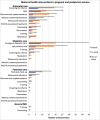Delivering maternal and neonatal health interventions in conflict settings: a systematic review
- PMID: 33608264
- PMCID: PMC7903125
- DOI: 10.1136/bmjgh-2020-003750
Delivering maternal and neonatal health interventions in conflict settings: a systematic review
Abstract
Background: While much progress was made throughout the Millennium Development Goals era in reducing maternal and neonatal mortality, both remain unacceptably high, especially in areas affected by humanitarian crises. While valuable guidance on interventions to improve maternal and neonatal health in both non-crisis and crisis settings exists, guidance on how best to deliver these interventions in crisis settings, and especially in conflict settings, is still limited. This systematic review aimed to synthesise the available literature on the delivery on maternal and neonatal health interventions in conflict settings.
Methods: We searched MEDLINE, Embase, CINAHL and PsycINFO databases using terms related to conflict, women and children, and maternal and neonatal health. We searched websites of 10 humanitarian organisations for relevant grey literature. Publications reporting on conflict-affected populations in low-income and middle-income countries and describing a maternal or neonatal health intervention delivered during or within 5 years after the end of a conflict were included. Information on population, intervention, and delivery characteristics were extracted and narratively synthesised. Quantitative data on intervention coverage and effectiveness were tabulated but no meta-analysis was undertaken.
Results: 115 publications met our eligibility criteria. Intervention delivery was most frequently reported in the sub-Saharan Africa region, and most publications focused on displaced populations based in camps. Reported maternal interventions targeted antenatal, obstetric and postnatal care; neonatal interventions focused mostly on essential newborn care. Most interventions were delivered in hospitals and clinics, by doctors and nurses, and were mostly delivered through non-governmental organisations or the existing healthcare system. Delivery barriers included insecurity, lack of resources and lack of skilled health staff. Multi-stakeholder collaboration, the introduction of new technology or systems innovations, and staff training were delivery facilitators. Reporting of intervention coverage or effectiveness data was limited.
Discussion: The relevant existing literature focuses mostly on maternal health especially around the antenatal period. There is still limited literature on postnatal care in conflict settings and even less on newborn care. In crisis settings, as much as in non-crisis settings, there is a need to focus on the first day of birth for both maternal and neonatal health. There is also a need to do more research on how best to involve community members in the delivery of maternal and neonatal health interventions.
Prospero registration number: CRD42019125221.
Keywords: child health; maternal health.
© Author(s) (or their employer(s)) 2021. Re-use permitted under CC BY. Published by BMJ.
Conflict of interest statement
Competing interests: None declared.
Figures






Similar articles
-
Delivery of sexual and reproductive health interventions in conflict settings: a systematic review.BMJ Glob Health. 2020 Jul;5(Suppl 1):e002206. doi: 10.1136/bmjgh-2019-002206. BMJ Glob Health. 2020. PMID: 32694131 Free PMC article.
-
Delivering infectious disease interventions to women and children in conflict settings: a systematic reviefw.BMJ Glob Health. 2020 Apr;5(Suppl 1):e001967. doi: 10.1136/bmjgh-2019-001967. BMJ Glob Health. 2020. PMID: 32341087 Free PMC article.
-
Delivering water, sanitation and hygiene interventions to women and children in conflict settings: a systematic review.BMJ Glob Health. 2020 Jul;5(Suppl 1):e002064. doi: 10.1136/bmjgh-2019-002064. BMJ Glob Health. 2020. PMID: 32641288 Free PMC article.
-
Delivering mental health and psychosocial support interventions to women and children in conflict settings: a systematic review.BMJ Glob Health. 2020 Mar 15;5(3):e002014. doi: 10.1136/bmjgh-2019-002014. eCollection 2020. BMJ Glob Health. 2020. PMID: 32201624 Free PMC article.
-
Delivering non-communicable disease interventions to women and children in conflict settings: a systematic review.BMJ Glob Health. 2020 Apr;5(Suppl 1):e002047. doi: 10.1136/bmjgh-2019-002047. BMJ Glob Health. 2020. PMID: 32341086 Free PMC article.
Cited by
-
Midwife-led birthing centre in the humanitarian setup: An experience from the Rohingya camp, Bangladesh.PLOS Glob Public Health. 2024 Dec 10;4(12):e0004033. doi: 10.1371/journal.pgph.0004033. eCollection 2024. PLOS Glob Public Health. 2024. PMID: 39656692 Free PMC article.
-
Measurement of the burdens of neonatal disorders in 204 countries, 1990-2019: a global burden of disease-based study.Front Public Health. 2024 Jan 9;11:1282451. doi: 10.3389/fpubh.2023.1282451. eCollection 2023. Front Public Health. 2024. PMID: 38264240 Free PMC article.
-
Pregnancy and neonatal outcomes in Eastern Democratic Republic of the Congo: a systematic review.Front Glob Womens Health. 2024 Dec 5;5:1412403. doi: 10.3389/fgwh.2024.1412403. eCollection 2024. Front Glob Womens Health. 2024. PMID: 39703717 Free PMC article.
-
The Effectiveness of Regionalization of Perinatal Care and Specific Facility-Based Interventions: A Systematic Review.Neonatology. 2025;122(Suppl 1):245-261. doi: 10.1159/000541384. Epub 2024 Nov 6. Neonatology. 2025. PMID: 39504943 Free PMC article.
-
The delivery of essential newborn care in conflict settings: A systematic review.Front Pediatr. 2022 Nov 1;10:937751. doi: 10.3389/fped.2022.937751. eCollection 2022. Front Pediatr. 2022. PMID: 36389389 Free PMC article. Review.
References
-
- World Health Organization Trends in maternal mortality: 2000 to 2017: estimates by who, UNICEF, UNFPA, world bank group and the United nations population division. Geneva: WHO, 2019.
-
- World Health organization Newborns: reducing mortality, 2019. Available: https://www.who.int/en/news-room/fact-sheets/detail/newborns-reducing-mo...
Publication types
MeSH terms
LinkOut - more resources
Full Text Sources
Other Literature Sources
Medical
Miscellaneous
